Beatriz Soret
Learning Decentralized Routing Policies via Graph Attention-based Multi-Agent Reinforcement Learning in Lunar Delay-Tolerant Networks
Oct 23, 2025Abstract:We present a fully decentralized routing framework for multi-robot exploration missions operating under the constraints of a Lunar Delay-Tolerant Network (LDTN). In this setting, autonomous rovers must relay collected data to a lander under intermittent connectivity and unknown mobility patterns. We formulate the problem as a Partially Observable Markov Decision Problem (POMDP) and propose a Graph Attention-based Multi-Agent Reinforcement Learning (GAT-MARL) policy that performs Centralized Training, Decentralized Execution (CTDE). Our method relies only on local observations and does not require global topology updates or packet replication, unlike classical approaches such as shortest path and controlled flooding-based algorithms. Through Monte Carlo simulations in randomized exploration environments, GAT-MARL provides higher delivery rates, no duplications, and fewer packet losses, and is able to leverage short-term mobility forecasts; offering a scalable solution for future space robotic systems for planetary exploration, as demonstrated by successful generalization to larger rover teams.
Scheduling Agile Earth Observation Satellites with Onboard Processing and Real-Time Monitoring
Jun 13, 2025Abstract:The emergence of Agile Earth Observation Satellites (AEOSs) has marked a significant turning point in the field of Earth Observation (EO), offering enhanced flexibility in data acquisition. Concurrently, advancements in onboard satellite computing and communication technologies have greatly enhanced data compression efficiency, reducing network latency and congestion while supporting near real-time information delivery. In this paper, we address the Agile Earth Observation Satellite Scheduling Problem (AEOSSP), which involves determining the optimal sequence of target observations to maximize overall observation profit. Our approach integrates onboard data processing for real-time remote monitoring into the multi-satellite optimization problem. To this end, we define a set of priority indicators and develop a constructive heuristic method, further enhanced with a Local Search (LS) strategy. The results show that the proposed algorithm provides high-quality information by increasing the resolution of the collected frames by up to 10% on average, while reducing the variance in the monitoring frequency of the targets within the instance by up to 83%, ensuring more up-to-date information across the entire set compared to a First-In First-Out (FIFO) method.
Energy efficiency of DMAs vs. conventional MIMO: a sensitivity analysis
Jun 10, 2025Abstract:Motivated by the stringent and challenging need for `greener communications' in increasingly power-hungry 5G networks, this paper presents a detailed energy efficiency analysis for three different multi-antenna architectures, namely fully-digital arrays, hybrid arrays, and dynamic metasurface antennas (DMAs). By leveraging a circuital model, which captures mutual coupling, insertion losses, propagation through the waveguides in DMAs and other electromagnetic phenomena, we design a transmit Wiener filter solution for the three systems. We then use these results to analyze the energy efficiency, considering different consumption models and supplied power, and with particular focus on the impact of the physical phenomena. DMAs emerge as an efficient alternative to classical arrays across diverse tested scenarios, most notably under low transmission power, strong coupling, and scalability requirements.
Timely Communication from Sensors for Wireless Networked Control in Cloud-Based Digital Twins
Aug 05, 2024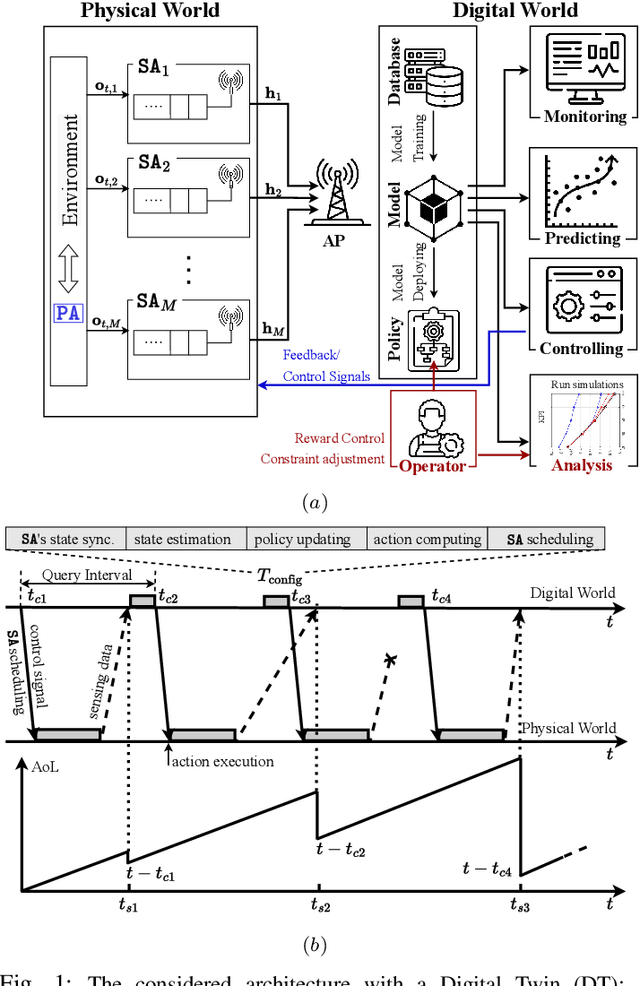
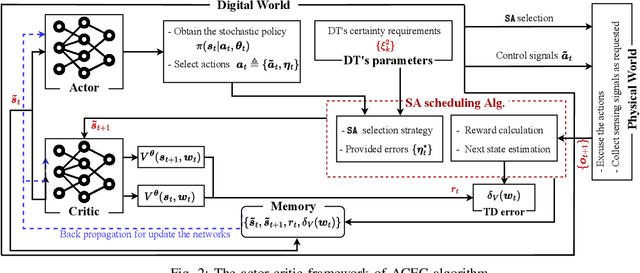


Abstract:We consider a Wireless Networked Control System (WNCS) where sensors provide observations to build a DT model of the underlying system dynamics. The focus is on control, scheduling, and resource allocation for sensory observation to ensure timely delivery to the DT model deployed in the cloud. \phuc{Timely and relevant information, as characterized by optimized data acquisition policy and low latency, are instrumental in ensuring that the DT model can accurately estimate and predict system states. However, optimizing closed-loop control with DT and acquiring data for efficient state estimation and control computing pose a non-trivial problem given the limited network resources, partial state vector information, and measurement errors encountered at distributed sensing agents.} To address this, we propose the \emph{Age-of-Loop REinforcement learning and Variational Extended Kalman filter with Robust Belief (AoL-REVERB)}, which leverages an uncertainty-control reinforcement learning solution combined with an algorithm based on Value of Information (VoI) for performing optimal control and selecting the most informative sensors to satisfy the prediction accuracy of DT. Numerical results demonstrate that the DT platform can offer satisfactory performance while halving the communication overhead.
Continual Deep Reinforcement Learning for Decentralized Satellite Routing
May 20, 2024Abstract:This paper introduces a full solution for decentralized routing in Low Earth Orbit satellite constellations based on continual Deep Reinforcement Learning (DRL). This requires addressing multiple challenges, including the partial knowledge at the satellites and their continuous movement, and the time-varying sources of uncertainty in the system, such as traffic, communication links, or communication buffers. We follow a multi-agent approach, where each satellite acts as an independent decision-making agent, while acquiring a limited knowledge of the environment based on the feedback received from the nearby agents. The solution is divided into two phases. First, an offline learning phase relies on decentralized decisions and a global Deep Neural Network (DNN) trained with global experiences. Then, the online phase with local, on-board, and pre-trained DNNs requires continual learning to evolve with the environment, which can be done in two different ways: (1) Model anticipation, where the predictable conditions of the constellation are exploited by each satellite sharing local model with the next satellite; and (2) Federated Learning (FL), where each agent's model is merged first at the cluster level and then aggregated in a global Parameter Server. The results show that, without high congestion, the proposed Multi-Agent DRL framework achieves the same E2E performance as a shortest-path solution, but the latter assumes intensive communication overhead for real-time network-wise knowledge of the system at a centralized node, whereas ours only requires limited feedback exchange among first neighbour satellites. Importantly, our solution adapts well to congestion conditions and exploits less loaded paths. Moreover, the divergence of models over time is easily tackled by the synergy between anticipation, applied in short-term alignment, and FL, utilized for long-term alignment.
Multi-Agent Deep Reinforcement Learning for Distributed Satellite Routing
Feb 27, 2024Abstract:This paper introduces a Multi-Agent Deep Reinforcement Learning (MA-DRL) approach for routing in Low Earth Orbit Satellite Constellations (LSatCs). Each satellite is an independent decision-making agent with a partial knowledge of the environment, and supported by feedback received from the nearby agents. Building on our previous work that introduced a Q-routing solution, the contribution of this paper is to extend it to a deep learning framework able to quickly adapt to the network and traffic changes, and based on two phases: (1) An offline exploration learning phase that relies on a global Deep Neural Network (DNN) to learn the optimal paths at each possible position and congestion level; (2) An online exploitation phase with local, on-board, pre-trained DNNs. Results show that MA-DRL efficiently learns optimal routes offline that are then loaded for an efficient distributed routing online.
Goal-Oriented and Semantic Communication in 6G AI-Native Networks: The 6G-GOALS Approach
Feb 12, 2024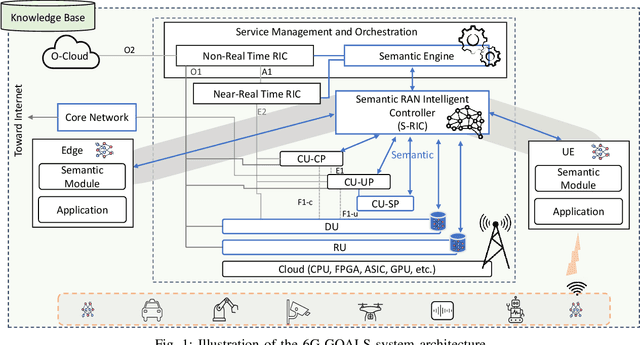

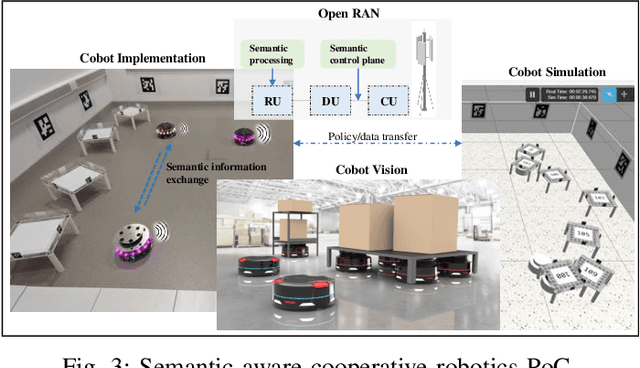
Abstract:Recent advances in AI technologies have notably expanded device intelligence, fostering federation and cooperation among distributed AI agents. These advancements impose new requirements on future 6G mobile network architectures. To meet these demands, it is essential to transcend classical boundaries and integrate communication, computation, control, and intelligence. This paper presents the 6G-GOALS approach to goal-oriented and semantic communications for AI-Native 6G Networks. The proposed approach incorporates semantic, pragmatic, and goal-oriented communication into AI-native technologies, aiming to facilitate information exchange between intelligent agents in a more relevant, effective, and timely manner, thereby optimizing bandwidth, latency, energy, and electromagnetic field (EMF) radiation. The focus is on distilling data to its most relevant form and terse representation, aligning with the source's intent or the destination's objectives and context, or serving a specific goal. 6G-GOALS builds on three fundamental pillars: i) AI-enhanced semantic data representation, sensing, compression, and communication, ii) foundational AI reasoning and causal semantic data representation, contextual relevance, and value for goal-oriented effectiveness, and iii) sustainability enabled by more efficient wireless services. Finally, we illustrate two proof-of-concepts implementing semantic, goal-oriented, and pragmatic communication principles in near-future use cases. Our study covers the project's vision, methodologies, and potential impact.
Generative Network Layer for Communication Systems with Artificial Intelligence
Dec 08, 2023



Abstract:The traditional role of the network layer is the transfer of packet replicas from source to destination through intermediate network nodes. We present a generative network layer that uses Generative AI (GenAI) at intermediate or edge network nodes and analyze its impact on the required data rates in the network. We conduct a case study where the GenAI-aided nodes generate images from prompts that consist of substantially compressed latent representations. The results from network flow analyses under image quality constraints show that the generative network layer can achieve an improvement of more than 100% in terms of the required data rate.
Goal-Oriented Scheduling in Sensor Networks with Application Timing Awareness
Jun 06, 2023Abstract:Taking inspiration from linguistics, the communications theoretical community has recently shown a significant recent interest in pragmatic , or goal-oriented, communication. In this paper, we tackle the problem of pragmatic communication with multiple clients with different, and potentially conflicting, objectives. We capture the goal-oriented aspect through the metric of Value of Information (VoI), which considers the estimation of the remote process as well as the timing constraints. However, the most common definition of VoI is simply the Mean Square Error (MSE) of the whole system state, regardless of the relevance for a specific client. Our work aims to overcome this limitation by including different summary statistics, i.e., value functions of the state, for separate clients, and a diversified query process on the client side, expressed through the fact that different applications may request different functions of the process state at different times. A query-aware Deep Reinforcement Learning (DRL) solution based on statically defined VoI can outperform naive approaches by 15-20%.
NGSO Constellation Design for Global Connectivity
Apr 09, 2022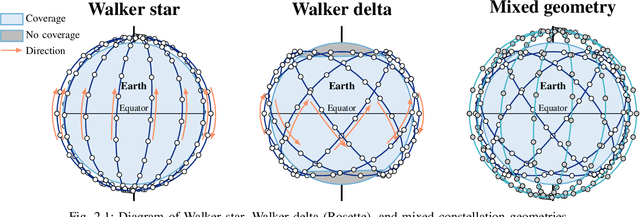
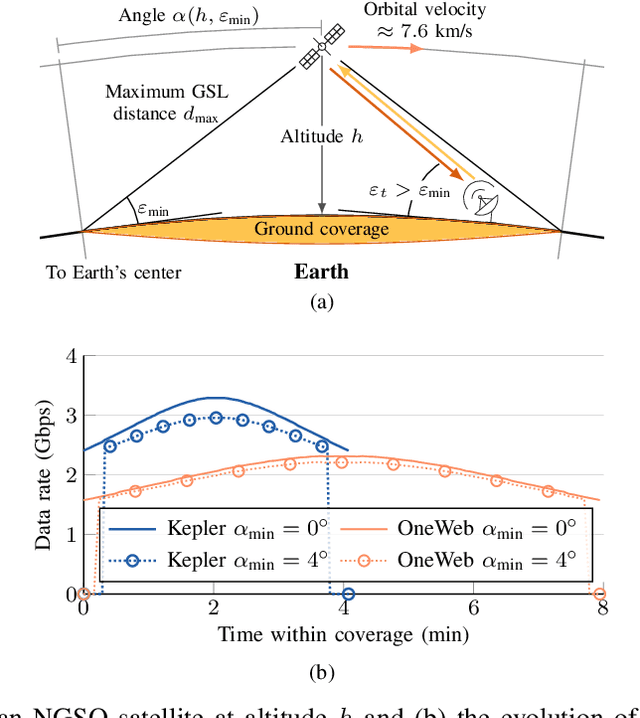

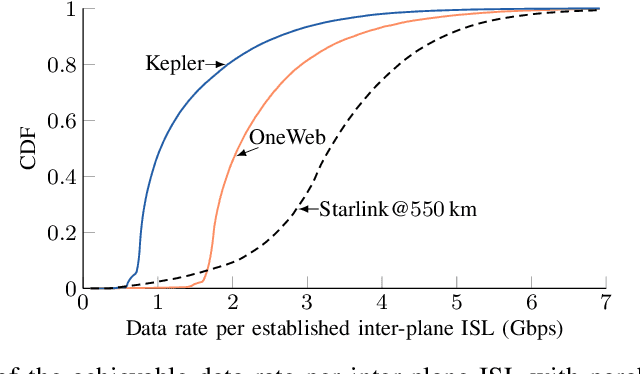
Abstract:Non-geostationary orbit (NGSO) satellite constellations represent a cornerstone in the NewSpace paradigm and thus have become one of the hottest topics for the industry, academia, but also for national space agencies and regulators. For instance, numerous companies worldwide, including Starlink, OneWeb, Kepler, SPUTNIX, and Amazon have started or will soon start to deploy their own NGSO constellations, which aim to provide either broadband or IoT services. One of the major drivers for such a high interest on NGSO constellations is that, with an appropriate design, they are capable of providing global coverage and connectivity.
 Add to Chrome
Add to Chrome Add to Firefox
Add to Firefox Add to Edge
Add to Edge